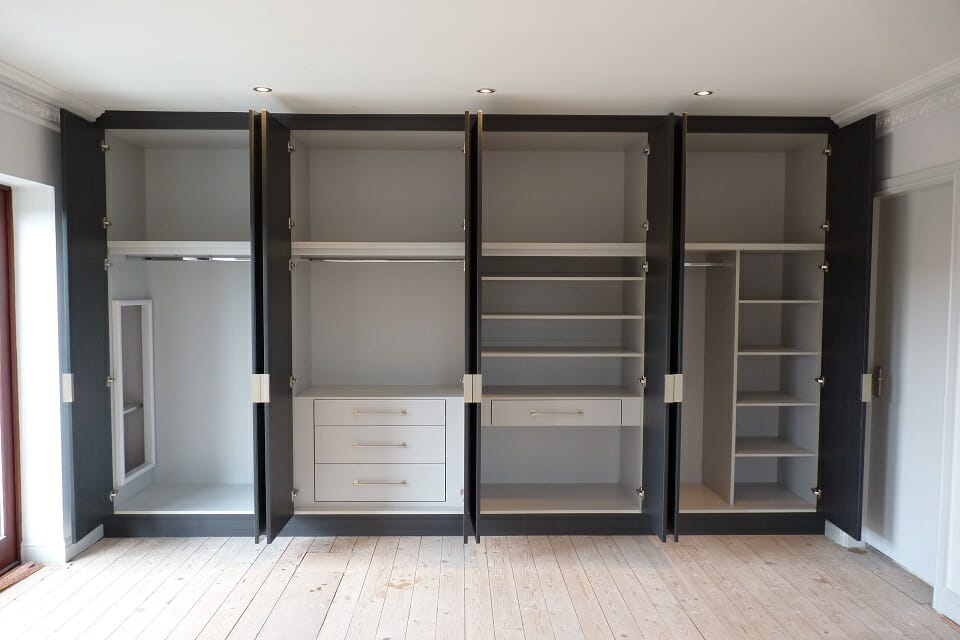
Wardrobes are necessary home additions, yet selecting the right one can be tricky. While they are vitally functional, they also retain some specific aesthetic purpose that can enhance or clash with your home’s décor. Therefore, selecting the right wardrobe to install within a particular space calls for more consideration than you might think.
There is more to selecting the ideal wardrobe than simply installing a storage solution. You must also account for various aspects, including size, purpose, design, and appearance within the room. All these factors may seem overwhelming. So, this article offers a comprehensive guide to built-in wardrobes.
Benefits of In-Built Wardrobes
Before diving into the intricacies of wardrobe design and appearance, it is best to understand why opting for in-built wardrobes is such a good idea.
Advantage #1: Customised Interiors
Built-in wardrobes allow you to customise their interiors based on your storage needs. Consequently, you have complete creative control and can add anything from double hanger rods to extra loft space. As an additional advantage, you can eliminate the need for extra dressers and organisers, thus maximising your space usage.
Advantage #2: Custom Façade
In addition to customised interiors, in-built wardrobes allow you to dictate their exterior appearance. With this freedom comes the ability to select the material, colour, and finish that will reflect and complement your chosen colour palette and design themes.
Disadvantages of In-Built Wardrobes
#1: Fixed in Place
Since built-in wardrobes are fixed, you cannot move them around while altering the room’s layout. So, if you like changing things up often, having an in-built wardrobe may limit your options.
#2: Permanent
Built-in wardrobes are fixed entities in both name and nature. Therefore, you cannot alter their placement unless you decide to break them down entirely and start again in another spot (which can be very costly).

Constructing and Installing Built-In Wardrobes
It was mentioned above that the interiors of in-built wardrobes are highly customizable. So, when designing yours, you have to remember the three primary parts of the closet:
- Hanging space: Makes closet organisation much more effortless. Moreover, it allows you to display your clothes more prominently.
- Drawers: Ideal for storing socks, delicates, accessories, or items you can’t hang up.
- Shelves: These work well for loungewear, jeans, knits, t-shirts, or any other garment that folds easily but isn’t delicate. Moreover, stands at the bottom of the wardrobe are ideal for seasonal footwear.
Pro tip: It is better to have more hanging space than shelves or drawers.
Positioning these three parts of a wardrobe relies on whether you install sliding or hinged doors. Thus, if you opt for hinged doors, you must set the drawers and shelves in the middle for easy access, while sliding doors call for them to be on the side.
Before drawing up any potential designs for your built-in wardrobe, you must take crucial measurements of the space where you will install the closet and keep them handy throughout. These measurements include:
- External dimensions.
- Internal dimensions.
- Compartment measurements.
You can opt for open instead of closed in-built wardrobe designs if you are more adventurous. This choice allows you to have your clothes on display at all times. On the other hand, it encourages you to remain organised and maintain the storage space well. But please note that you must consider installing transparent doors if your place is prone to dust.
The material you select to construct your wardrobe must be durable yet aesthetically pleasing. The most popular option, in this case, is glossy or matte plywood, as it can support heavy weights.

Lighting
You may need to install some lighting in your in-built wardrobe. Determining this necessity relies on your room’s lighting levels and the wardrobe’s depth. Conversely, you may opt to incorporate some lights regardless of what is already available. In this case, glow in the closet boosts ambient lighting, enabling you to see better.
If you opt to install lights in the wardrobe, you must ensure that you choose fixtures that diffuse light without emitting heat. Therefore, it is best to choose LED lights/bulbs. These lights come in various shapes that fit nicely in various locations.
In-built wardrobes allow you to exercise creativity while preserving your vision of the ideal closet and room aesthetic. So, take advantage of the flexibility and freedom on offer and make the right choices.












